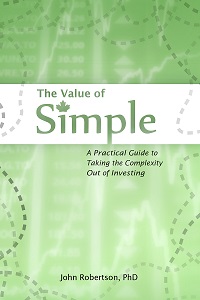Potato’s Short Guide to DIY Investing
November 4th, 2011 by PotatoPlease note: Potato’s Short Guide to DIY Investing will be sunsetting in November 2014. It has been superseded by The Value of Simple.
Hey, I have short book! And it’s about financial literacy/investing for yourself!
It’s called Potato’s Short Guide to DIY Investing. And it’s exactly what it sounds like: a short guide (~40 letter-sized pages; ~90 paperback/kobo-sized pages) that brings a novice investor up to speed on how to get into do-it-yourself investing. It very quickly covers what to invest in (stocks, bonds, mutual funds), where to put it (non-registered, TFSA, RRSP), how to get it there (how to set up an account, what fees to look out for), and what to think about along the way (planning, asset allocation). In other words, all the basics condensed into one little package. It focuses on low-cost index investing, but doesn’t spend much time saying why you should choose that over some other kind of investing a novice has never heard of, it just gets right into the how.
Indeed, that’s one of the most unique features of the book (that, and a light, humourous tone with pictures of bunnies): it’s exclusively for Canadians (so TFSA and RRSPs, no IRAs and 401ks) and it actually tells you how to take the next step and get started with setting up an account including screenshots from TD.
The book is inexpensive at just $5, in part because it’s self-published electronically: you can buy it either from Amazon for the Kindle, the Kobo store, or directly from me in PDF and ePub.
What’s covered?
A number of important basics are covered, including:
- The importance of investing: time & compound returns.
- Types of investments, from cash to bonds and stocks.
- Mutual funds as collections of other things like stocks & bonds, and the importance of fees.
- Stocks & risk.
- Passive investing, including four major indexes to follow.
- Historical returns and approximately how to set your expectations.
- Taxation, TFSA, and RRSP.
- What inflation is, and why it can be a big deal for your long-term plan.
- Asset allocation and rebalancing.
- Putting it into practice: opening an account and making your first purchase.
Why should I buy the book?
There are many good reasons, and none of them silly like with physical paper books (no holding up wobbly tables with this one!). In particular, it is a concise, well-written introduction to investing for the novice investor. In just a few hours you can get yourself up and running, and have an idea of what to read next to build up your knowledge base.
Saving for the future is an important part of life, but it can also be a little overwhelming, especially when it comes to investing. It’s not something the schools have prepared you for, yet getting someone else to manage your money can be costly, with advisors or mutual funds often taking 2.5% or more per year in fees – that’s a cost of $1250 for a $50,000 investment, every year.
Do-it-yourself investing and managing your own money is something that anyone can do with just a little bit of time, dedication, and education. Once you learn the basics, a passive investing strategy requires very little of your ongoing time to maintain. A few hours at tax time perhaps. A few minutes through the rest of the year as you make money and have more investments to put away.
You just need the basic knowledge to get started, and that’s exactly what the book has been written to deliver.
It’s been favourably reviewed by everyone that’s provided feedback, and not all of them are just trying to be nice to me (though to be fair, I still haven’t heard back from some reviewers). Plus, it’s not expensive, so you’re not exactly taking a big risk on it. Here’s an example review (chosen since it was spontaneous feedback from someone that doesn’t know me personally, so it should be the least biased): “I read your book over the weekend. Great summary. This exactly what I needed to start with investing.”
See? Exactly what you need. It does kind of nicely collect a lot of stuff into one spot.
Will it reveal heretofore unknown secrets of wealth, and tell me how to get rich quick? ‘Cause that’d totally be worth $5.
Unfortunately, no. There’s no special knowledge. I may have re-worded and packaged things better than others, and I may not have, but either way there’s really nothing that’s totally unique to this book. If you really want to get your information for free, pretty much everything in there is available on the web or from other books. I’d bet at least half the topics have already been covered on this very site. However, if you place much value on your time, you’d probably spend a lot more than $5 tracking it all down, especially if you weren’t quite sure where to start in the first place.
What’s the target audience?
The book is primarily aimed at people that want to invest for themselves. It discusses a passive indexing method, and most of the information is kept at a general level: enough to get by and get started, but not enough detail to become a real specialist. So if you already have a good background knowledge in markets and how to invest on your own, you may not need the book. However, if you’ve already read a bunch of stuff on index investing, but still don’t know how to actually go about doing it, then you’d probably still find this book quite useful. In terms of ages, in my mind I was writing it for my friends, in the 20-40 age range. It talks a lot about saving and investing for the future, but does not cover how to turn around and start living off those savings once retirement actually starts. It should be appropriate for anyone who’s still in the saving phase of their life (typically, <65).
If you read the terms “TFSA, RRSP, and non-registered” in the first bit, and didn’t know what that meant, then the book is absolutely for you.
Can I see a preview?
I’ll be posting excerpts here and as guest posts on other blogs as I start promoting the book. I’ll add links here as the excerpts are posted, but in the meantime just trust that the writing quality is as good or better than the typical BbtP post (likely much better since this has gone through several revisions and reviewers).
The story behind the book.
Planning.
How do I buy the book again?
It’s very easy, and you have a few choices:
Visit the book’s page here and buy directly from me.
Visit Amazon’s Kindle store and buy it from them for the Kindle, or a compatible reader app for your smartphone, tablet, or computer. Or, if you have a Kobo or other ePub reader (Sony, etc.), then go to the Kobo store (or directly from me).



 Questrade: use QPass 356624159378948
Questrade: use QPass 356624159378948 Passiv is a tool that can connect to your Questrade account and make it easier to track and rebalance your portfolio, including the ability to make one-click trades.
Passiv is a tool that can connect to your Questrade account and make it easier to track and rebalance your portfolio, including the ability to make one-click trades.